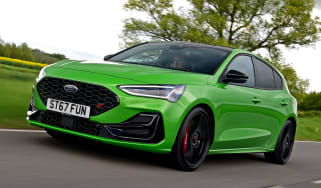Ford Focus hatchback (2011-2014) - MPG, running costs & CO2
The new Ford Focus has impressive range of engines, with low running costs across the board.
The Ford Focus was launched in 2011 and it was beginning to lag behind newer rivals like the latest Volkswagen Golf and new Peugeot 308 for emissions and economy. However, the facelift in late 2014 introduced a range of new engines and technologies that closed the gap.
MPG and CO2
The cleanest model in the range is the 1.5-litre TDCi diesel, which boasts fuel economy of 74.3mpg and CO2 emissions of 98g/km. It only costs £100 more than the old 1.6-litre TDCi diesel, which is less powerful, less economical and emits more CO2. We’d say shell out the extra and get the new engine.
The other highlight of the Focus engine range is the 1.0-litre three-cylinder EcoBoost turbocharged petrol. This award-winning engine was introduced as a cleaner replacement for Ford’s standard 1.6-litre petrol. It emits 105g/km of CO2 in 99bhp form and 108g/km in more powerful 123bhp configuration. That means road tax and company-car costs are competitive, although we’ve found that the respective claimed MPG figures of 61.4mpg and 60.1mpg are hard to achieve in real-world driving. Ford is known to be working on a 99g/km version of this engine, too.
Insurance group
Insurance groups are pretty reasonable throughout the Focus range, thanks in part to its range of safety features. The automatic city braking system, for example, knocks a couple of groups off the final insurance rating.
Servicing
With over 750 dealers across the UK, Ford has the largest franchise network of any manufacturer, and if you stick to the service schedule, you’ll be visiting one every year or 12,500 miles. However, quantity doesn’t equal quality, and Ford’s dealers don’t have the best reputation. Customers complained about a lack of personal service and an inability to find the cause of problems in the Driver Power survey.
Warranty
All Ford Focus models come with a three-year/60,000-mile warranty (although you can pay to extend this to four or even five years) plus one year’s roadside assistance. Ford also offers two or three-year servicing deals, although these offers are expensive when compared to similar deals offered by rival manufacturers.
Past incarnations of the Focus aren’t known for good residual values, and while the current Focus can’t match the VW Golf or SEAT Leon, the range average is around 40 per cent, which is on a par with the Skoda Octavia and ahead of rivals such as the Hyundai i30 and Peugeot 308.
The Focus range kicks of with the basic Studio model, which is priced the same as a mid-spec Fiesta supermini. Then it’s a jump of nearly £3,000 to the Style models, with Zetec versions costing £1,000 more than that and top-spec Titanium X models around £4,000 more again. The most expensive automatic diesel comes close to £24,000. The Focus Estate costs £1,100 more than the equivalent hatchback.
Compared to rivals, the Focus is competitively priced. There are plenty of options available and dealers are open to haggling, so you could get a decent discount off the list price. The Focus ST is something of a bargain compared to rival hot hatchbacks, and – like the Skoda Octavia vRS – it’s also available as an estate.














